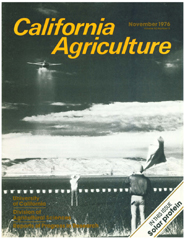Calag Archive
Calag Archive
Volume 30, Number 11
News and opinion
A major portion of the estimated $200 million annual losses of fruit and vegetable during shipment and marketing can be attributed to disease caused by less than a dozen fungi and bacteria. Significent progress has been made in controlling these diseases.



